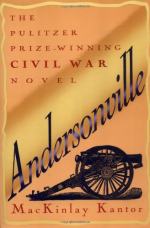The negros displayed all the musical creativeness of that section. Their wonderful prolificness in wild, rude songs, with strangely melodious airs that burned themselves into the memory, was one of the salient characteristics of that down-trodden race. Like the Russian serfs, and the bondmen of all ages and lands, the songs they made and sang all had an undertone of touching plaintiveness, born of ages of dumb suffering. The themes were exceedingly simple, and the range of subjects limited. The joys, and sorrows, hopes and despairs of love’s gratification or disappointment, of struggles for freedom, contests with malign persons and influences, of rage, hatred, jealousy, revenge, such as form the motifs for the majority of the poetry of free and strong races, were wholly absent from their lyrics. Religion, hunger and toil were their main inspiration. They sang of the pleasures of idling in the genial sunshine; the delights of abundance of food; the eternal happiness that awaited them in the heavenly future, where the slave-driver ceased from troubling and the weary were at rest; where Time rolled around in endless cycles of days spent in basking, harp in hand, and silken clad, in golden streets, under the soft effulgence of cloudless skies, glowing with warmth and kindness emanating from the Creator himself. Had their masters condescended to borrow the music of the slaves, they would have found none whose sentiments were suitable for the ode of a people undergoing the pangs of what was hoped to be the birth of a new nation.
The three songs most popular at the South, and generally regarded as distinctively Southern, were “The Bonnie Blue Flag,” “Maryland, My Maryland,” and “Stonewall Jackson Crossing into Maryland.” The first of these was the greatest favorite by long odds. Women sang, men whistled, and the so-called musicians played it wherever we went. While in the field before capture, it was the commonest of experiences to have Rebel women sing it at us tauntingly from the house that we passed or near which we stopped. If ever near enough a Rebel camp, we were sure to hear its wailing crescendo rising upon the air from the lips or instruments of some one more quartered there. At Richmond it rang upon us constantly from some source or another, and the same was true wherever else we went in the so-called Confederacy.
All familiar with Scotch songs will readily recognize the name and air as an old friend, and one of the fierce Jacobite melodies that for a long time disturbed the tranquility of the Brunswick family on the English throne. The new words supplied by the Rebels are the merest doggerel, and fit the music as poorly as the unchanged name of the song fitted to its new use. The flag of the Rebellion was not a bonnie blue one; but had quite as much red and white as azure. It did not have a single star, but thirteen.
Near in popularity was “Maryland, My Maryland.” The versification of this was of a much higher Order, being fairly respectable. The air is old, and a familiar one to all college students, and belongs to one of the most common of German household songs:




